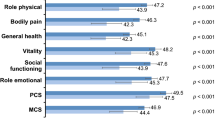Abstract
Although the 36-Item Short-Form General Health Survey (SF-36) has been utilized to assess quality of life (QoL) in cross-sectional studies, no longitudinal studies have evaluated this instrument in stone formers. Hence, we evaluated the performance of the SF-36 over time in a group of stone formers. From January to May 2007, the SF-36 was administered by independent interviewers to 155 patients with a history of stones, and 96 individuals subsequently completed a second questionnaire at a median interval of 18 months (10.3–28.5 months). Subjects were asked to report changes in stone status, interval procedures, and significant non-stone related changes. Changes in individual and composite scores of SF-36 were compared. Among the 96 patients who completed two SF-36 surveys, 75 patients denied experiencing a stone episode within the month preceding their initial or follow-up SF-36 form. No statistically significant differences in any of the SF-36 domains or the aggregate physical or mental health composite scores over time were noted in these patients. A total of 18 patients reported a stone event within the month preceding completion of the initial questionnaire but no stone event prior to the follow-up survey. No clinically or statistically significant changes in any of the SF-36 domains between the first and follow-up questionnaire were seen among these 18 patients. The results show the stability of the SF-36 over time in patients with no change in their stone status. However, the absence of significant changes in the SF-36 despite a change in stone status suggests that the SF-36 may not be an adequate tool to monitor quality of life over time in stone patients. Validated, disease-specific questionnaires are needed to facilitate comparison of treatment strategies for stone disease.
Similar content being viewed by others
References
Stamatelou KK, Francis ME, Jones CA, Nyberg LM, Curhan GC (2003) Time trends in reported prevalence of kidney stones in the United States: 1976–1994. Kidney Int 63:1817–1823
Lotan Y, Cadeddu JA, Roerhborn CG, Pak CY, Pearle MS (2004) Cost-effectiveness of medical management strategies for nephrolithiasis. J Urol 172:2275–2281
American Urological Association Education and Research I, European Association of Urology: EAU/AUA Nephrolithiasis Guideline Panel. Guideline for the management of ureteral calculi, 2007, pp 61
Ikuerowo SO, Akindiji YO, Akinoso OA, Akinlusi FM, Esho JO (2008) Association between erectile dysfunction and lower urinary tract symptoms due to benign prostatic hyperplasia in Nigerian men. Urol Int 80:296–299
Gacci M, Bartoletti R, Figlioli S, Sarti E, Eisner B, Boddi V, Rizzo M (2003) Urinary symptoms, quality of life and sexual function in patients with benign prostatic hypertrophy before and after prostatectomy: a prospective study. BJU Int 91:196–200
Penniston KL, Nakada SY (2007) Health related quality of life differs between male and female stone formers. J Urol 178:2435–2440 (discussion pp 2440)
Bensalah K, Tuncel A, Gupta A, Raman JD, Pearle MS, Lotan Y (2008) Determinants of quality of life for patients with kidney stones. J Urol 179:2238–2243 (discussion pp 2243)
McHorney CA, Haley SM, Ware JE Jr (1997) Evaluation of the MOS SF-36 Physical Functioning Scale (PF-10): II. Comparison of relative precision using Likert and Rasch scoring methods. J Clin Epidemiol 50:451–461
Rule AD, Bergstralh EJ, Melton LJ 3rd, Li X, Weaver AL, Lieske JC (2009) Kidney stones and the risk for chronic kidney disease. Clin J Am Soc Nephrol 4:804–811
Diniz DH, Blay SL, Schor N (2007) Quality of life of patients with nephrolithiasis and recurrent painful renal colic. Nephron Clin Pract 106:c91–c97
Fukuhara S, Ware JE Jr, Kosinski M, Wada S, Gandek B (1998) Psychometric and clinical tests of validity of the Japanese SF-36 Health Survey. J Clin Epidemiol 51:1045–1053
Raman JD, Bagrodia A, Bensalah K, Pearle MS, Lotan Y (2010) Residual fragments after percutaneous nephrolithotomy: cost comparison of immediate second look flexible nephroscopy versus expectant management. J Urol 183:188–193
Bensalah K, Tuncel A, Raman JD, Bagrodia A, Pearle M, Lotan Y (2009) How physician and patient perceptions differ regarding medical management of stone disease. J Urol 182:998–1004
Paick JS, Kim SW, Oh SJ, Ku JH (2007) A generic health-related quality of life instrument, the Medical Outcomes Study Short Form-36, in women with urinary incontinence. Eur J Obstet Gynecol Reprod Biol 130:18–24
Guilfoyle MR, Seeley H, Laing RJ (2009) The Short Form 36 health survey in spine disease–validation against condition-specific measures. Br J Neurosurg 23:401–405
Rosen RC, Riley A, Wagner G, Osterloh IH, Kirkpatrick J, Mishra A (1997) The international index of erectile function (IIEF): a multidimensional scale for assessment of erectile dysfunction. Urology 49:822–830
van Venrooij GE, Boon TA, de Gier RP (1995) International prostate symptom score and quality of life assessment versus urodynamic parameters in men with benign prostatic hyperplasia symptoms. J Urol 153:1516–1519
Staios D, Andrews HO, Shaik T, Buchholz NN (2007) Quality of life after percutaneous nephrolithotomy for caliceal diverticulum and secluded lower-pole renal stones. J Endourol 21(5):515–519
Author information
Authors and Affiliations
Corresponding author
Rights and permissions
About this article
Cite this article
Donnally, C.J., Gupta, A., Bensalah, K. et al. Longitudinal evaluation of the SF-36 quality of life questionnaire in patients with kidney stones. Urol Res 39, 141–146 (2011). https://doi.org/10.1007/s00240-010-0313-2
Received:
Accepted:
Published:
Issue Date:
DOI: https://doi.org/10.1007/s00240-010-0313-2




